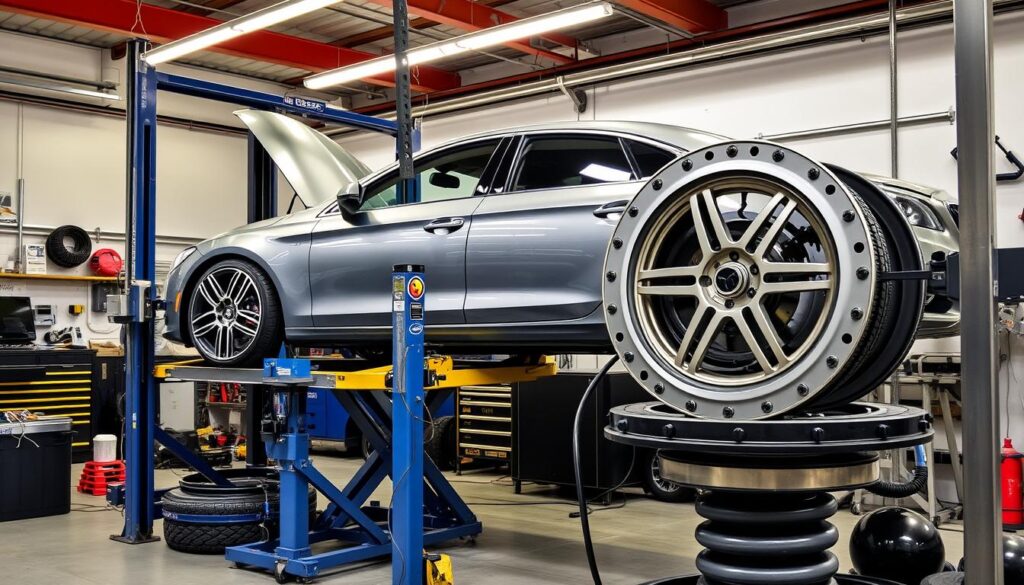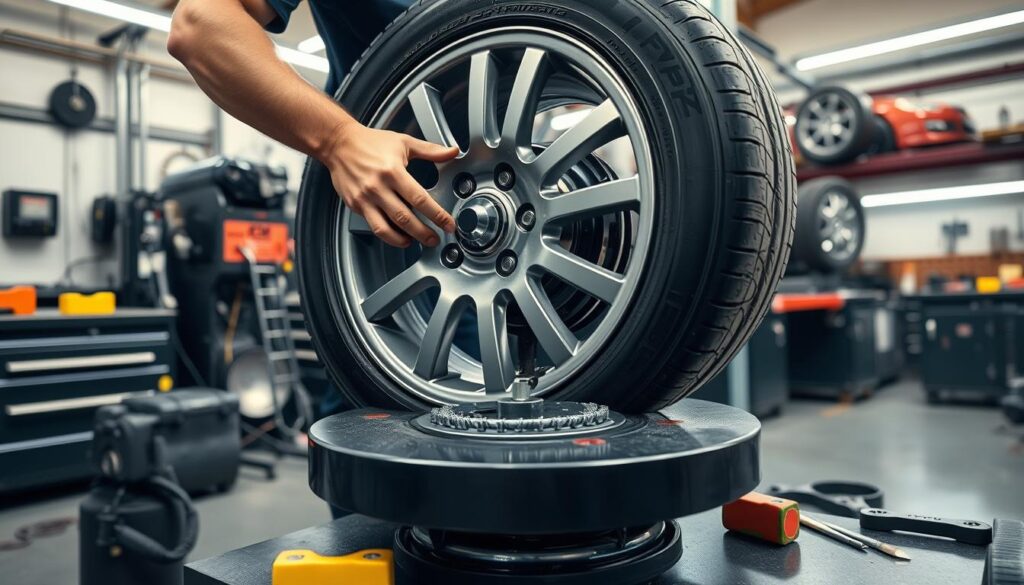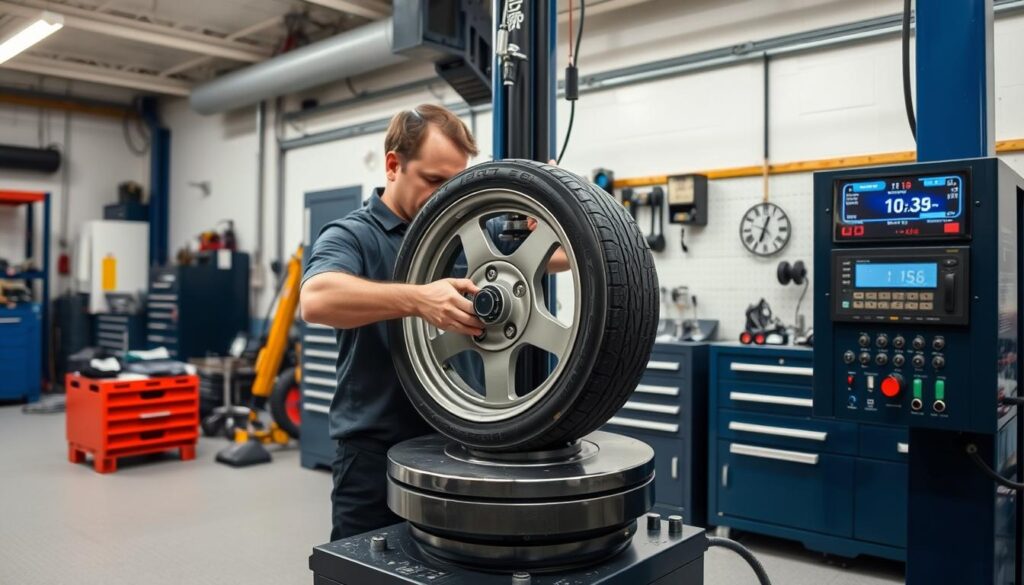As a car owner, I know how important regular care is. Two key services often missed are wheel alignment and balancing. This article will explain the difference between them. You’ll learn about wheel alignment and balancing and how they affect your car’s performance.

“An automotive workshop scene showcasing a car on a lift with wheel alignment equipment on one side and a balancing machine on the other, highlighting the contrast between precise adjustments and dynamic weights, surrounded by tools and mechanical parts, with a clean and organized ambiance.”
This article aims to teach you about wheel alignment and balancing. These services are vital for your car’s health. Knowing the difference helps keep your tires safe and your car running well.
Key Takeaways
- Wheel alignment and balancing are two separate services that are essential for vehicle maintenance.
- Wheel alignment explained refers to the process of adjusting the wheels to ensure they are properly aligned with the vehicle’s suspension.
- Wheel balancing vs alignment is a common debate, but both services are necessary for optimal vehicle performance.
- Regular wheel alignment and balancing can improve fuel efficiency and extend the life of your tires.
- Understanding the difference between wheel alignment and balancing can help you make informed decisions about your vehicle’s maintenance needs.
- By prioritizing wheel alignment and balancing, you can ensure your vehicle runs smoothly and safely.
Understanding Wheel Alignment and Balancing Basics
Keeping your wheels aligned and balanced is key for your car’s health. Wheel alignment makes your car run better and last longer. It also saves fuel and makes your car safer.
Wheel balancing makes your car smooth to ride. It keeps your tires healthy by avoiding uneven wear. This means your tires last longer and your car gets better gas mileage.
What is Wheel Alignment?
Wheel alignment means making sure your car’s wheels are set right. It adjusts the camber, toe, and caster. This keeps your car running smoothly.
What is Wheel Balancing?
Wheel balancing makes sure your car’s weight is spread evenly. It adds weights to the wheels. This reduces shakes and makes your car ride better.
Key Differences at a Glance
Here’s what sets wheel alignment and balancing apart:
- Alignment adjusts your car’s wheels to match the maker’s specs.
- Balance spreads your car’s weight evenly to smooth out rides.
In short, knowing about wheel alignment and balancing is vital. It keeps your car in top shape. By focusing on these, you make sure your car is safe and efficient.
The Key Difference Between Wheel Alignment and Balancing
Knowing the difference between wheel alignment explained and wheel balancing vs alignment is key. Wheel alignment makes sure the wheels are set right. Wheel balancing makes sure the wheels don’t vibrate or wear unevenly.
It’s important to know about these services for your car’s safety and how well it runs. Wheel alignment explained means adjusting the wheels so they’re just right. This makes your car use less gas, wear tires better, and drive smoother. Wheel balancing vs alignment makes sure the wheels are balanced, stopping vibrations and wear.
- Different goals: Alignment makes your car better to drive, balancing stops vibrations.
- How they work: Alignment changes the wheel angles, balancing changes the wheel weight.
- What they do: Alignment saves gas and tires, balancing keeps your car safe.
In short, knowing the difference between wheel alignment explained and wheel balancing vs alignment is key. It helps keep your car safe and running well. By understanding each service, you can choose what’s best for your car.
Signs Your Vehicle Needs Wheel Alignment
As a car owner, knowing when your car needs a wheel alignment is key. It’s important for your safety and how well your car runs. If you see any of these signs, it’s time to get your car checked.
Some common signs that your vehicle needs wheel alignment include:
- Vehicle pulling to one side: If your car is pulling to one side while driving, it may be a sign that your wheels are not properly aligned.
- Uneven tire wear: Uneven tire wear can be a sign of poor wheel alignment, which can lead to reduced tire life and decreased fuel efficiency.
- Steering wheel vibrations: Vibrations in the steering wheel can be a sign of wheel misalignment, which can cause discomfort while driving and affect your vehicle’s handling.
Regular wheel alignment keeps your car running well. It makes sure your car is safe and uses less fuel. By getting your car checked, you help your tires last longer and drive better.
Don’t wait until it’s too late – if you notice any of these signs, schedule a wheel alignment service today and keep your vehicle running at its best.
| Signs of Poor Wheel Alignment | Effects on Vehicle |
|---|---|
| Vehicle pulling to one side | Reduced safety, decreased fuel efficiency |
| Uneven tire wear | Reduced tire life, decreased fuel efficiency |
| Steering wheel vibrations | Discomfort while driving, affected handling |
Common Indicators of Unbalanced Wheels
As a car owner, knowing the signs of unbalanced wheels is key. It keeps your car safe and running well. Wheel balancing stops uneven tire wear. This means better fuel use and safer driving.
Look out for vibrations, uneven tire wear, and less fuel efficiency. The balancing process checks and adjusts wheels. This makes your car safer and your tires last longer.
Wheel balancing brings many benefits. Here are a few:
- Improved fuel efficiency
- Extended tire life
- Enhanced safety features
Knowing these signs and balancing your wheels helps your car run better. It keeps you safe on the road.

A close-up view of a wheel balancing machine in a well-lit automotive workshop, featuring a technician carefully placing a wheel onto the balancing spindle, colorful weights scattered around, tools on the workbench, and detailed machinery in the background. The atmosphere conveys precision and professionalism with a focus on the process of achieving perfect wheel balance.
Regular wheel balancing stops many problems. It keeps your car running smoothly and safely.
The Wheel Alignment Process Explained
Proper wheel alignment is key for your vehicle’s safety and performance. It involves adjusting the wheels to match the manufacturer’s specs. Knowing about wheel alignment and its cost is important. A good wheel alignment service can save you money by improving fuel efficiency and tire life.
The wheel alignment process includes three main adjustments:
Camber Adjustment
This adjustment makes sure the wheels are straight up and down. It’s important for even tire wear and good handling. A correct camber adjustment can also save you money by avoiding uneven tire wear.
Toe Alignment
This adjustment makes the wheels parallel and straight ahead. It’s key for stable handling and even tire wear. This can help lower the wheel alignment cost.
Caster Adjustment
This adjustment affects the steering and handling. A pro will set the caster right for a smooth drive.
In short, wheel alignment is vital for your vehicle’s safety and performance. It also affects the cost. Knowing about wheel alignment and its cost helps you make better choices for your vehicle. Regular checks can prevent expensive repairs and keep your vehicle running well.
How Wheel Balancing Works
Wheel balancing makes sure weight is evenly spread around the wheel. It’s different from tire alignment. Balancing focuses on the weight of the wheel and tire together.
A technician uses a balancing machine to check the wheel’s weight. This machine finds heavy spots that cause vibrations and wear. Then, the technician adds weights to balance it out for a smooth ride.
There are two balancing methods: static and dynamic. Static balancing checks the wheel when it’s not moving. Dynamic balancing checks it when it’s spinning. Dynamic balancing is more accurate and makes the ride smoother.

A mechanic’s workshop scene featuring a technician placing a wheel on a dynamic balancing machine, surrounded by tools, weights, and a digital display showing measurements. The environment is bright and organized, with a focus on the wheel and balancing process, showcasing precision and attention to detail.
Proper wheel balancing is very important. It makes the vehicle perform better and is safer. Knowing the difference between tire alignment and balancing helps owners take care of their vehicle. This ensures a safe and smooth ride.
| Method | Description |
|---|---|
| Static Balancing | Measures weight distribution when the wheel is stationary |
| Dynamic Balancing | Measures weight distribution when the wheel is spinning |
Cost Comparison: Alignment vs Balancing Services
Two important services for your car are wheel alignment and balancing. They cost differently. The wheel alignment cost is between $50 to $200. This depends on your car and the service place. The wheel balancing procedure costs $15 to $30 per tire.
Here’s a simple cost breakdown:
- Average wheel alignment cost: $100 to $150
- Typical wheel balancing procedure cost: $60 to $120 for all four tires
Things like where you are, labor costs, and equipment type change prices. Pick a service that fits your budget well.
Keeping your car in good shape makes it safer and more fuel-efficient. Regular wheel alignment and wheel balancing services make your car smoother. They also make your tires last longer.
| Service | Average Cost |
|---|---|
| Wheel Alignment | $100 to $150 |
| Wheel Balancing | $60 to $120 |
Maintenance Schedule and Recommendations
To make sure your car stays in good shape, it’s important to follow a regular maintenance plan. I suggest checking your wheel alignment every 6,000 to 8,000 miles. This might change based on how you drive and the roads you’re on.
Here are some key maintenance tips:
- Check tire pressure monthly to ensure proper inflation
- Rotate tires every 5,000 to 8,000 miles to promote even wear
- Inspect suspension and steering components for wear or damage
By sticking to this schedule, you’ll get the most out of your car. You’ll see better fuel efficiency, longer tire life, and safer driving. Remember, regular care keeps your car running well.
Also, keep a maintenance log to track your car’s history. This helps you spot problems early and keeps your car in great shape.
| Maintenance Task | Frequency |
|---|---|
| Tire pressure check | Monthly |
| Tire rotation | Every 5,000 to 8,000 miles |
| Wheel alignment check | Every 6,000 to 8,000 miles |
Benefits of Regular Wheel Maintenance
Keeping your wheels in check is key for your car’s health. A wheel alignment service brings many benefits. It makes your car run better and saves your tires.
One big plus is improved fuel efficiency. When wheels are aligned right, your car moves smoothly. This means you use less fuel and save money.
Also, extended tire life is a big win. Good alignment spreads out your car’s weight evenly. This stops tires from wearing down too fast. You’ll spend less on new tires.
Many benefits come from regular wheel care. These include:
- Improved fuel efficiency
- Extended tire life
- Enhanced safety features, such as better handling and reduced risk of accidents
Regular care makes driving smoother and safer. It’s smart to know about wheel alignment and balancing. This knowledge helps your car perform better.
Regular wheel care is easy and effective. A wheel alignment service and tire balancing keep your car in top shape. You’ll enjoy better driving and longer tire life.
| Benefit | Description |
|---|---|
| Improved Fuel Efficiency | Regular wheel maintenance can help improve fuel efficiency by reducing resistance and improving mileage. |
| Extended Tire Life | Proper wheel alignment and tire balancing can help extend the life of your tires by reducing uneven wear and tear. |
| Enhanced Safety Features | Regular wheel maintenance can help improve safety by reducing the risk of accidents and improving handling. |
DIY vs Professional Service: Making the Right Choice
Choosing between DIY and professional service for wheel alignment explained and wheel balancing vs alignment is tough. As a car owner, you must think about safety and your car’s life.
DIY might save money, but it can mess up your car. Professional services use special tools and know-how for the best wheel alignment explained and wheel balancing vs alignment. They offer:
- Accurate adjustments for your car’s best performance
- Special tools for exact measurements
- Experts with lots of wheel balancing vs alignment knowledge
When picking a pro, look at their reputation, experience, and certifications. A good service has the right skills and tools for safe wheel alignment explained and wheel balancing vs alignment.
In short, while DIY might look good, your safety and car’s health are more important. Choose professional wheel alignment explained and wheel balancing vs alignment services. This way, you get the best for your car’s life and performance.
Conclusion: Maintaining Your Vehicle’s Wheel Health
Knowing the difference between wheel alignment and wheel balancing is key. Wheel alignment makes sure your wheels are straight. Wheel balancing makes sure all tires are evenly weighted.
Keeping your wheels in good shape has many benefits. It can make your car use less fuel and last longer. It also makes your car safer.
Deciding to do it yourself or get a pro depends on your skills and your car’s needs. Taking care of your wheels is important for your car.
By keeping your wheels aligned and balanced, you get a better ride. Your tires will last longer, and your car will run better.
FAQs About Difference Between Wheel Alignment and Balancing
What is the difference between wheel alignment and balancing?
Wheel alignment and balancing are two important services for your car. Alignment makes sure the wheels point the right way and touch the road well. Balancing makes sure the wheel and tire don’t vibrate or wear out too fast.
Why is wheel alignment important?
Wheel alignment is key for your car’s safety and performance. It keeps your car steady and saves fuel. If not aligned, your car might pull to one side or vibrate, which is dangerous and costly.
How does wheel balancing work?
Balancing uses special tools to find any weight issues in the wheel and tire. Then, small weights are added to make it even. This makes your ride smoother and saves your tires.
What are the common signs that a vehicle needs wheel alignment or balancing?
Signs you need alignment or balancing include: – The car pulling to one side – Uneven tire wear – Steering wheel vibrations – Trouble staying straight while driving – Less fuel efficiency
How often should I get my wheels aligned and balanced?
How often depends on your car’s age and how much you drive. Usually, every 6,000 to 12,000 miles is good. Or, when you notice any issues.
How much do wheel alignment and balancing services typically cost?
Prices vary based on your car and where you go. Alignment costs $50 to $100. Balancing is $15 to $50 per tire.
Should I do wheel alignment and balancing myself or hire a professional?
DIY fans might try it, but it’s safer to let a pro do it. They have the right tools and know-how. Mistakes can be risky for your car.